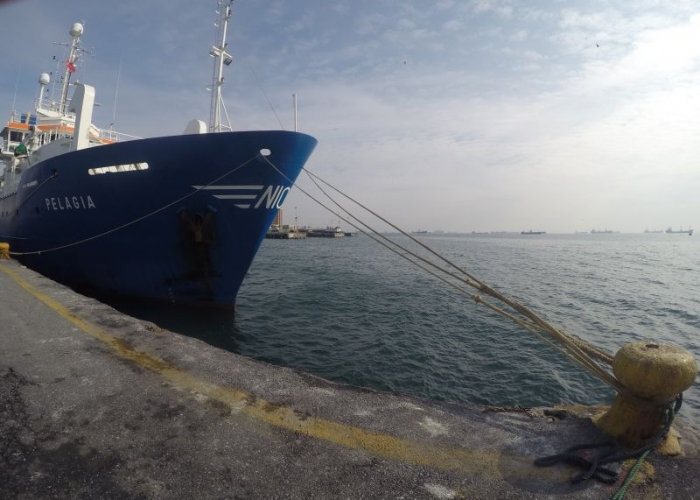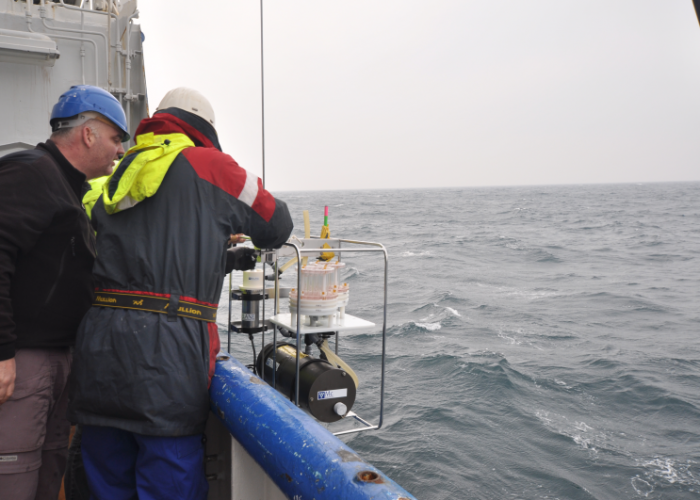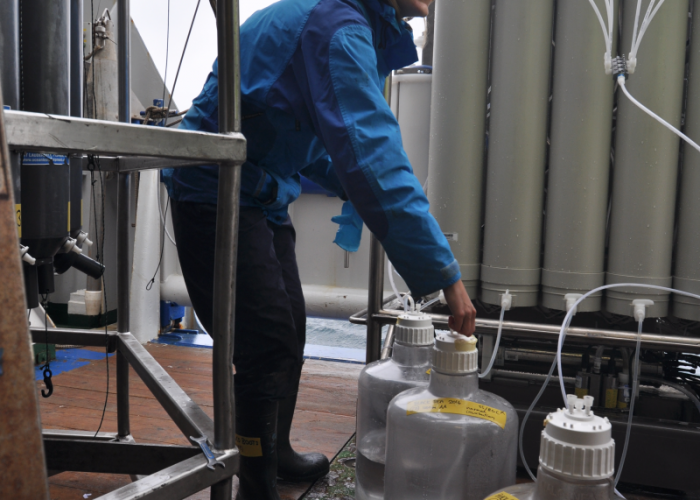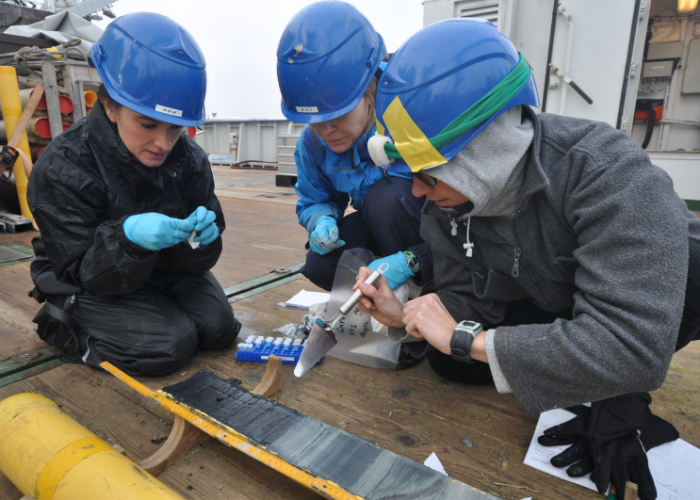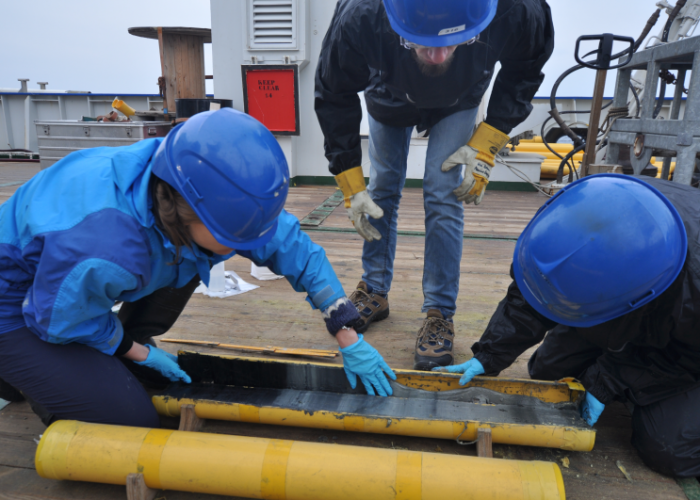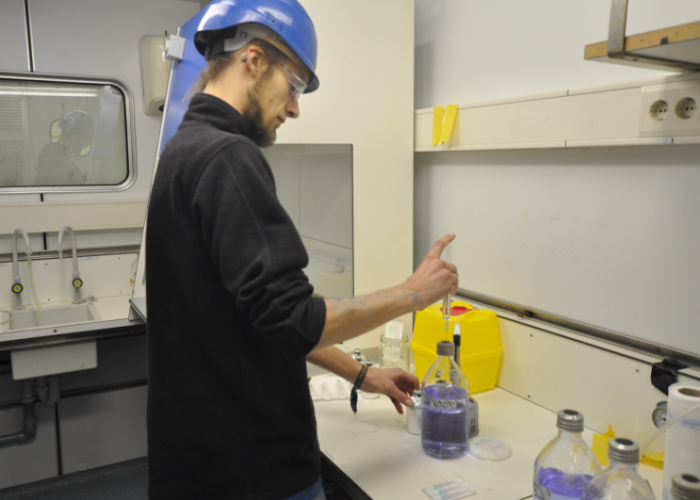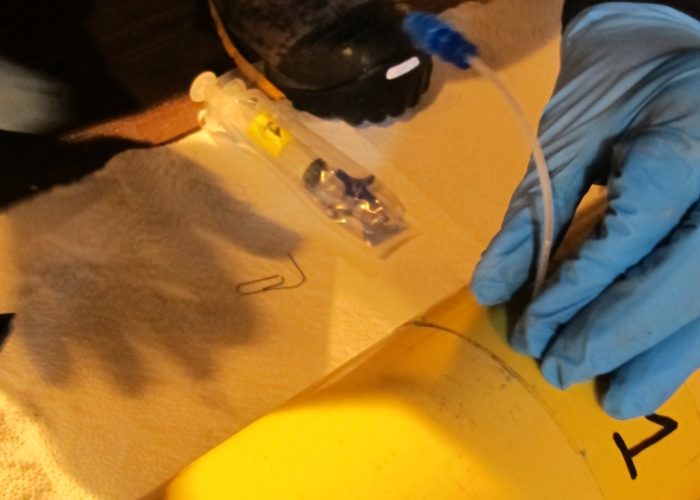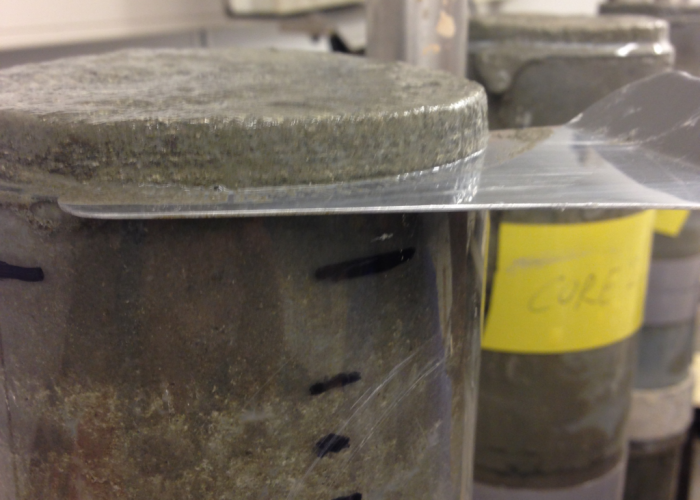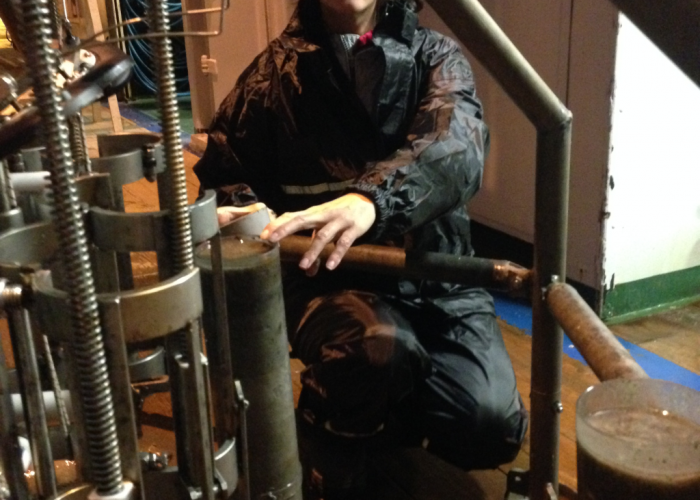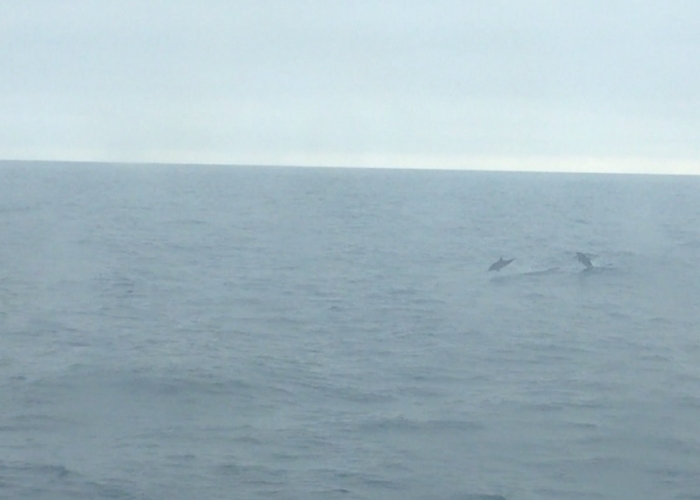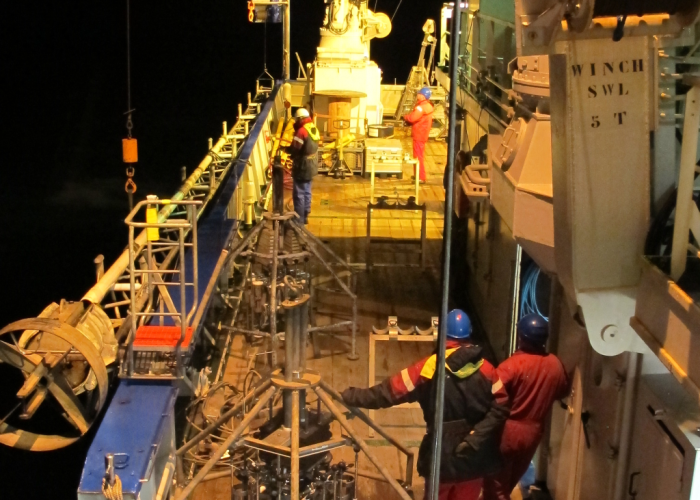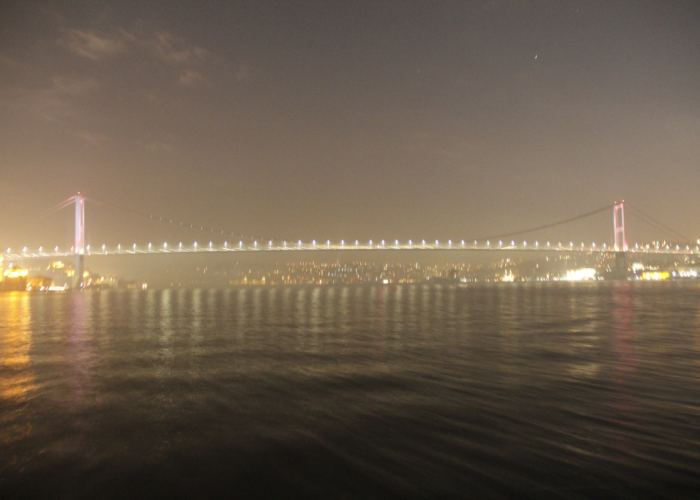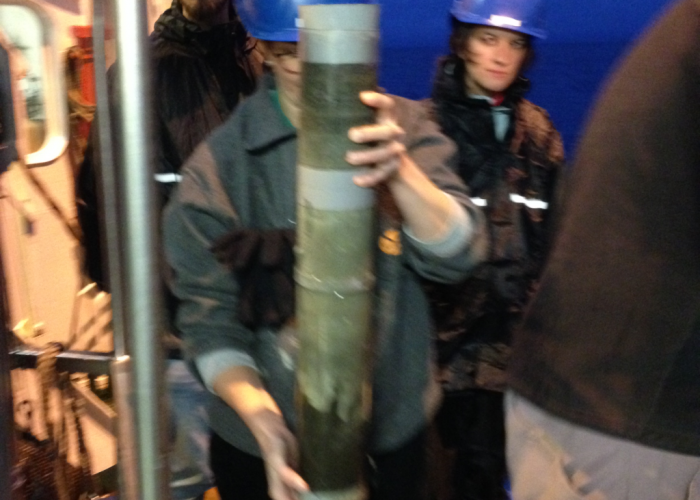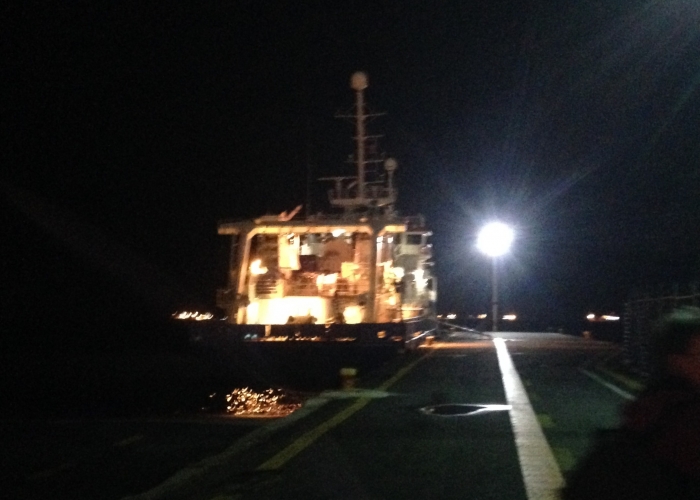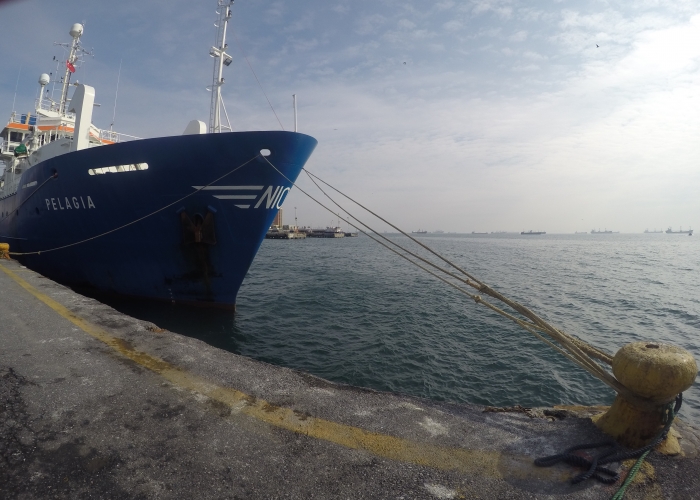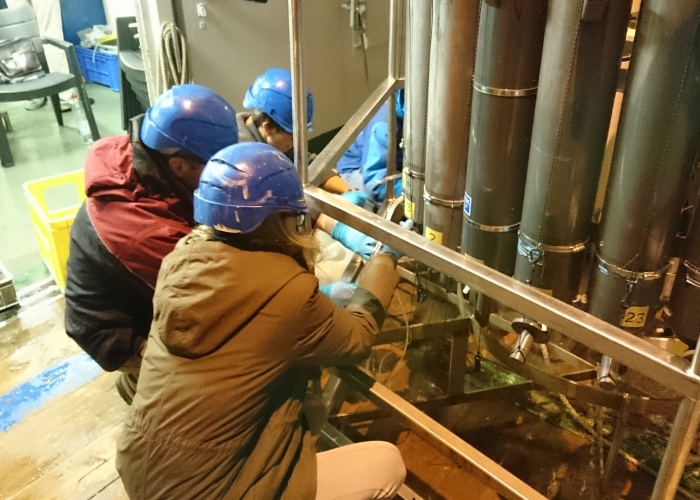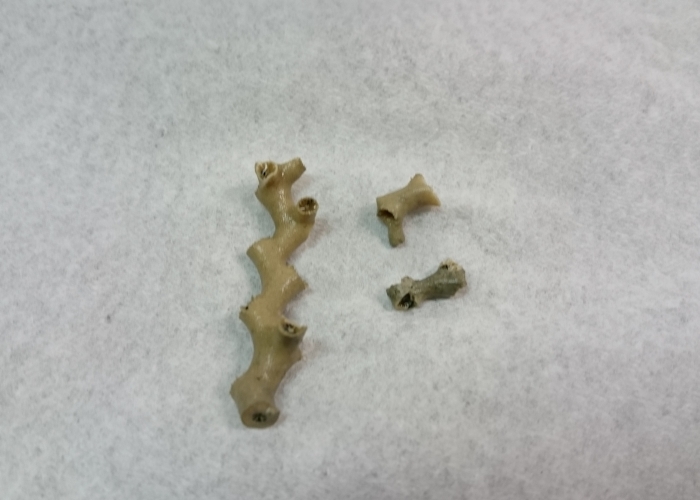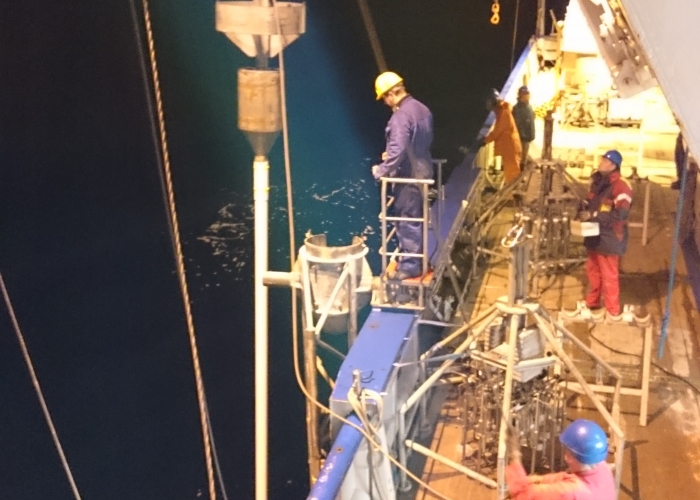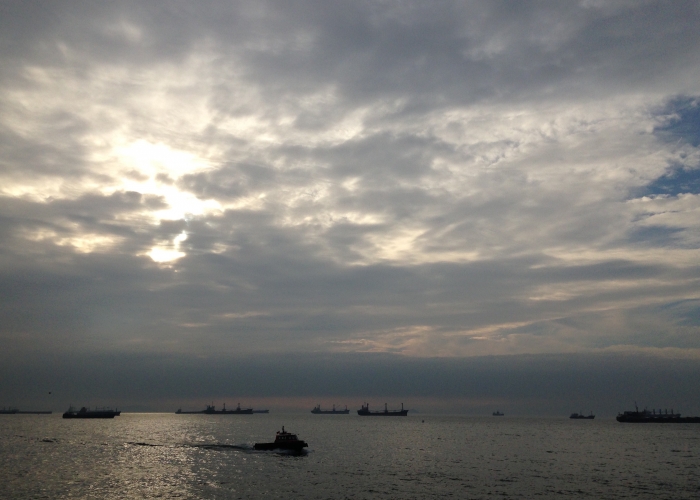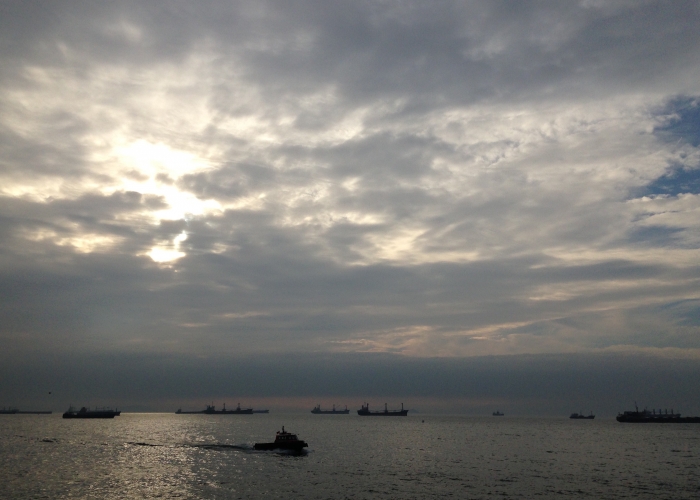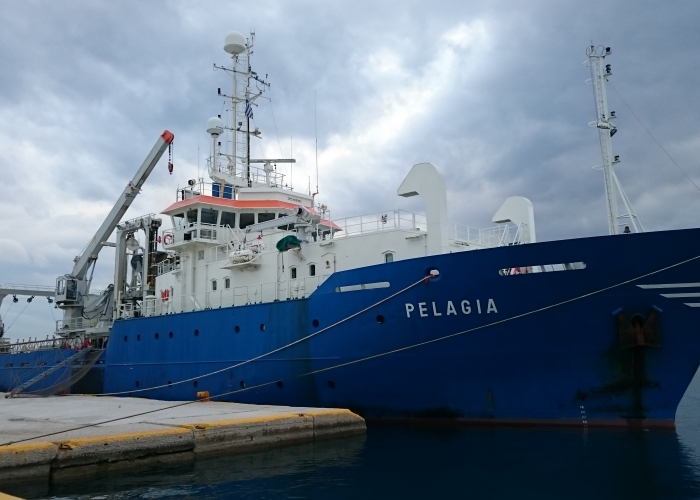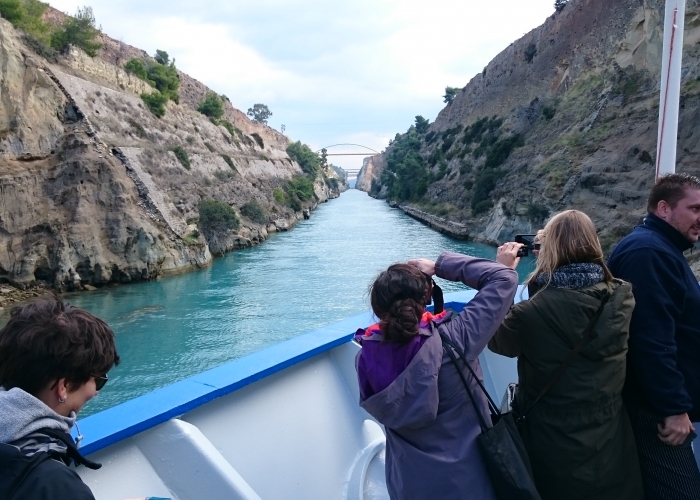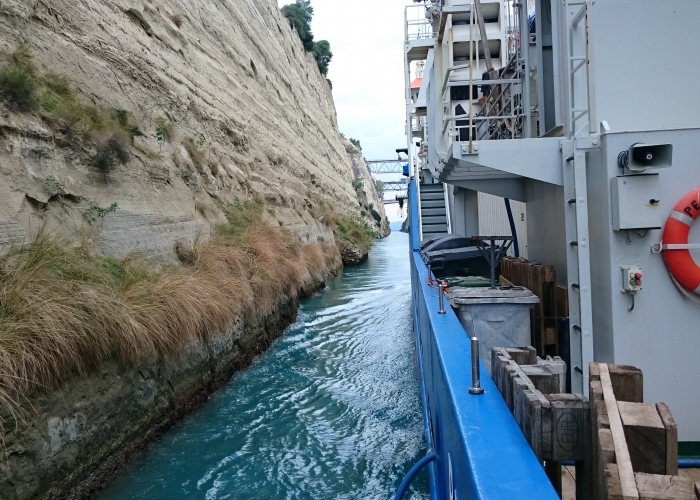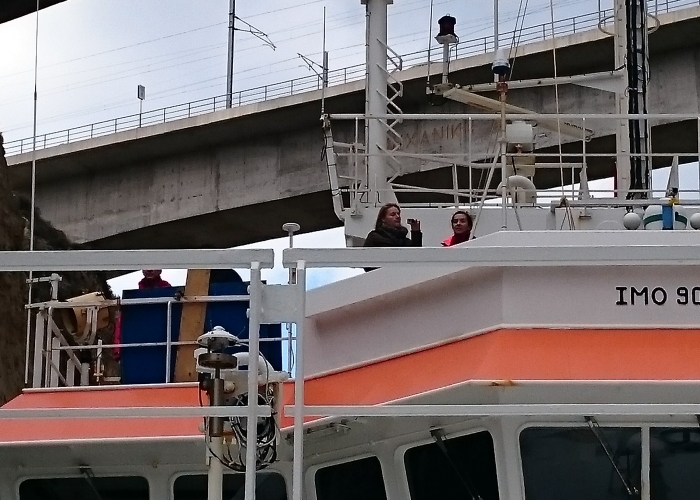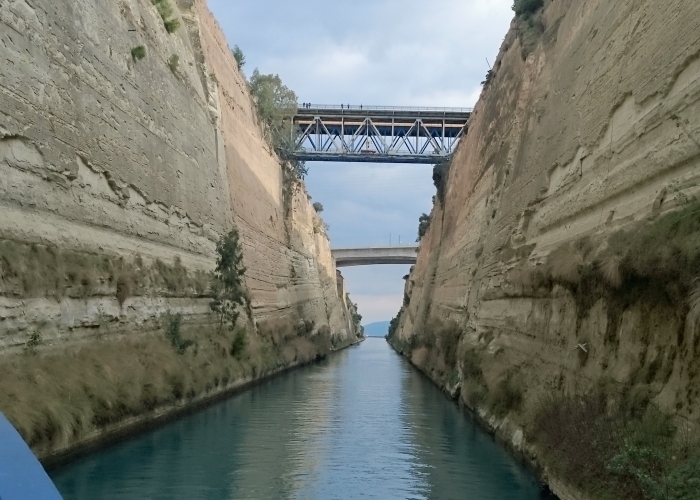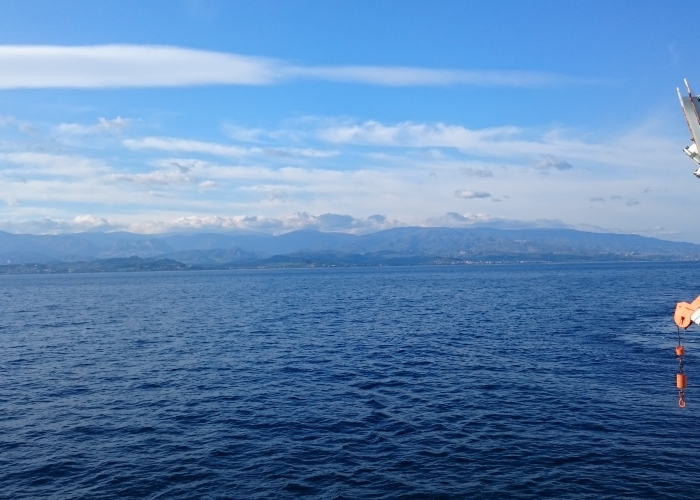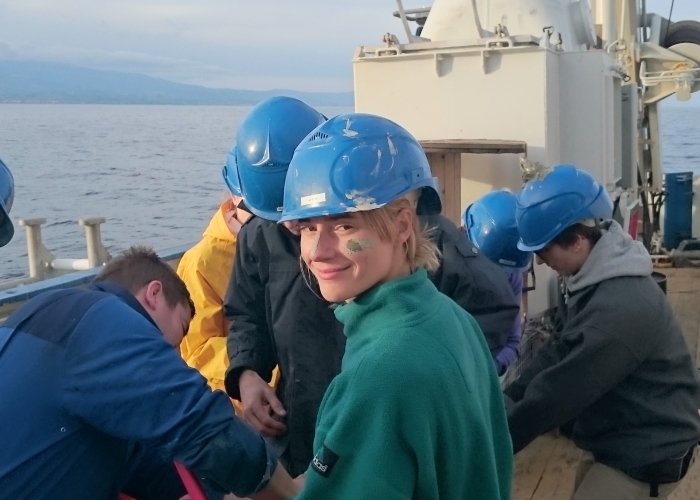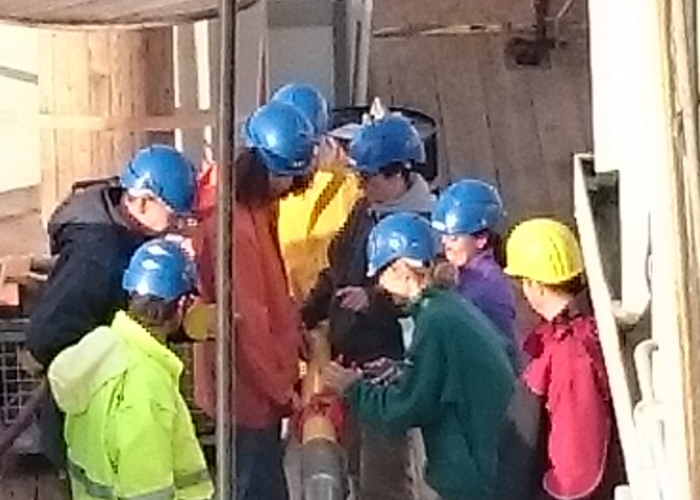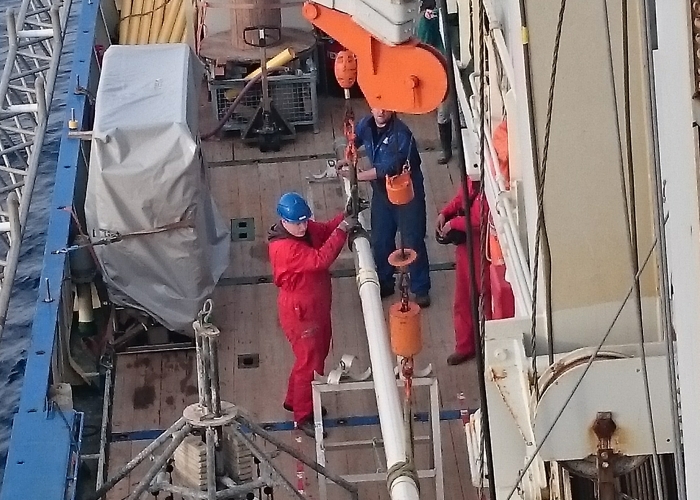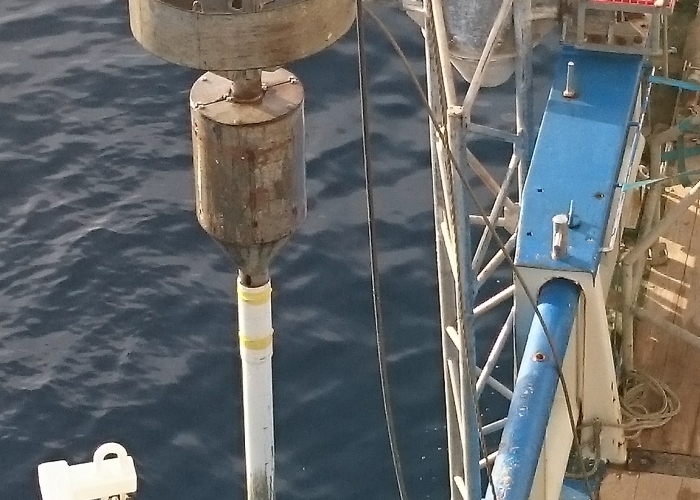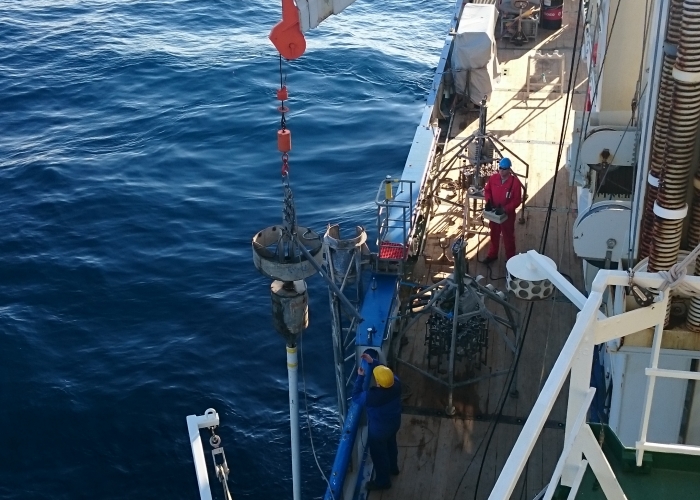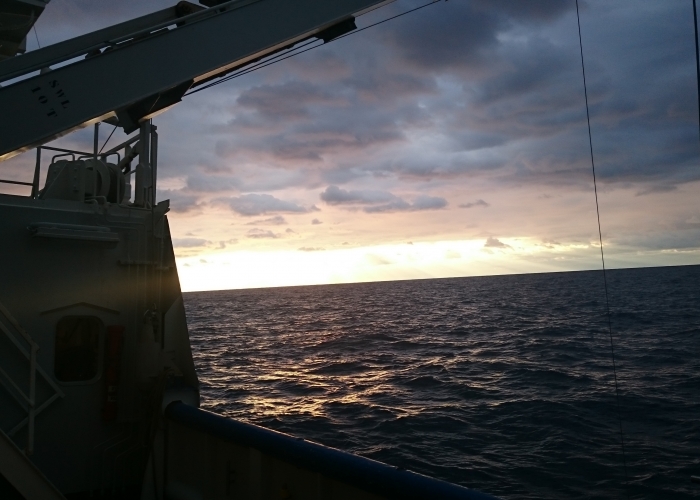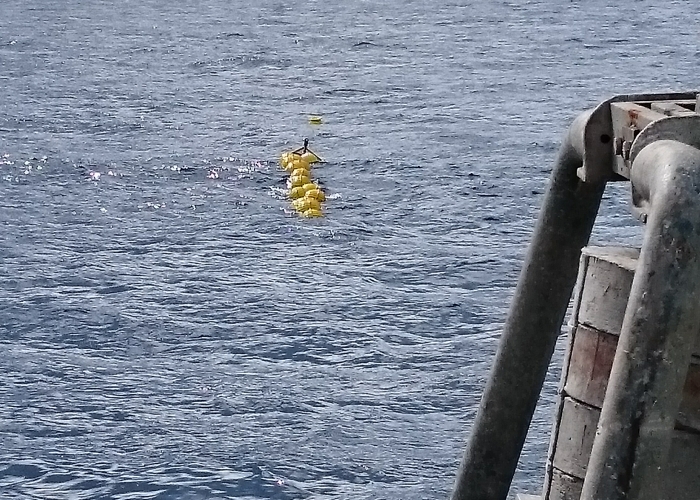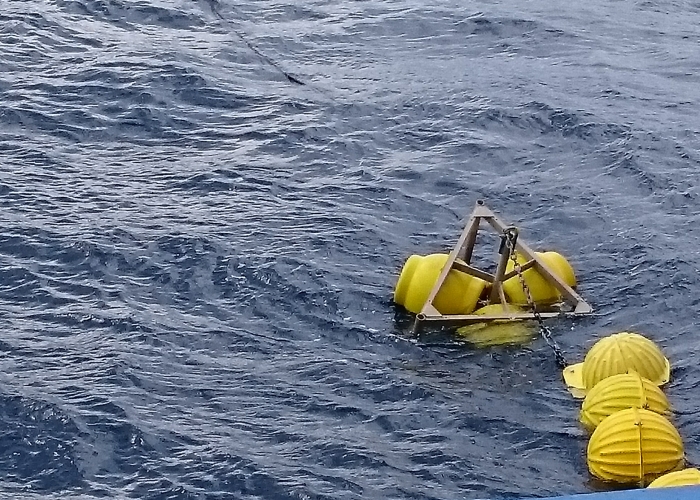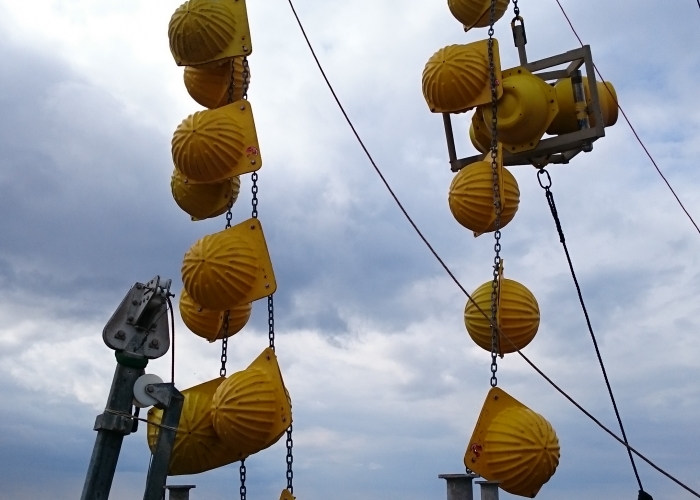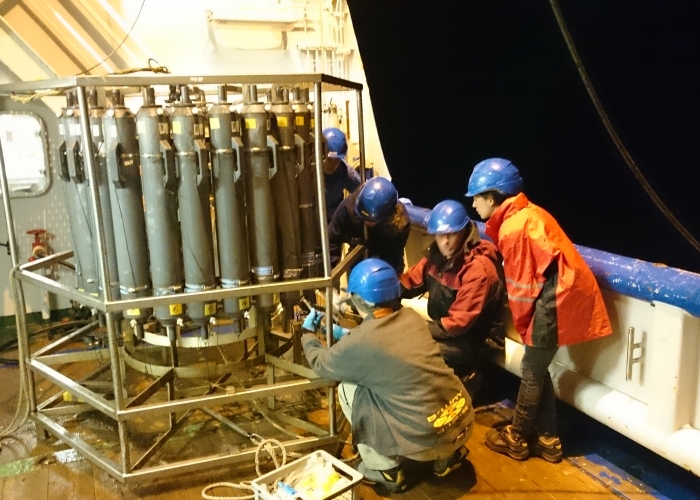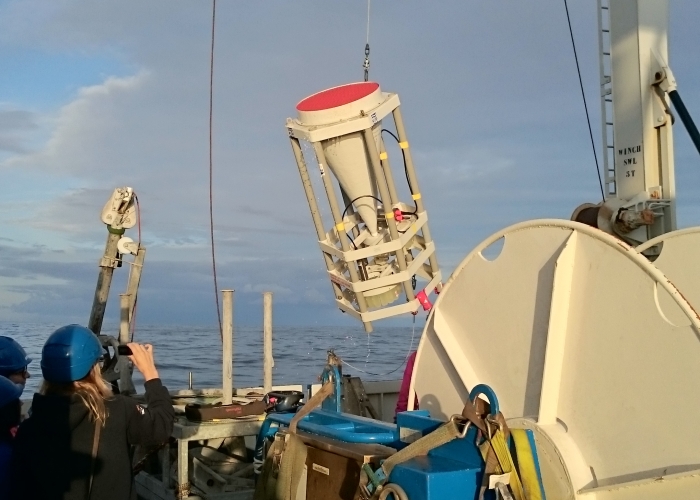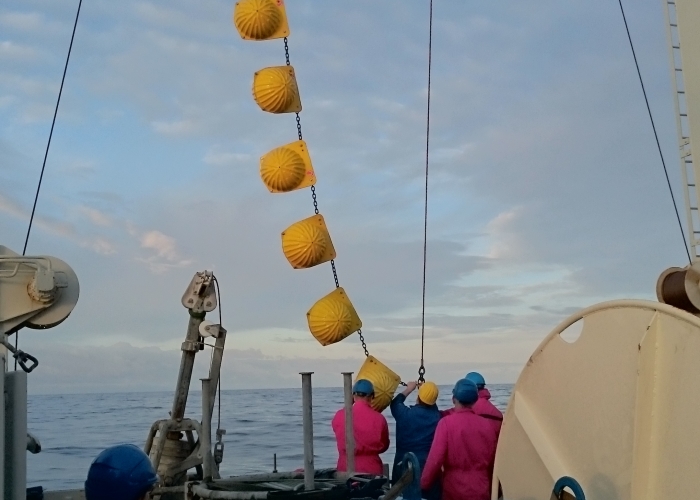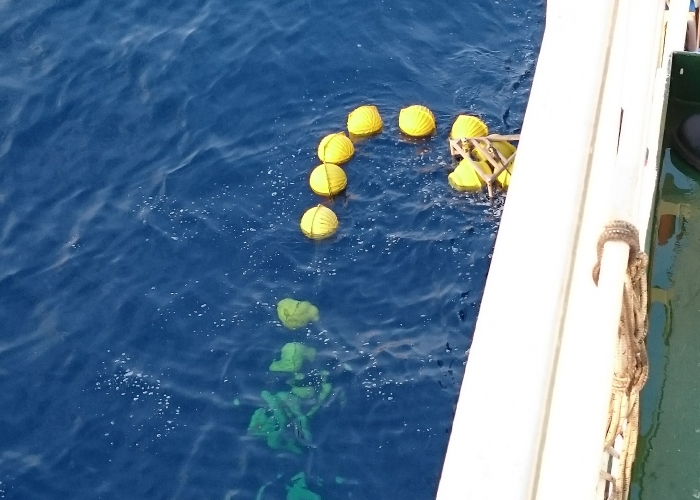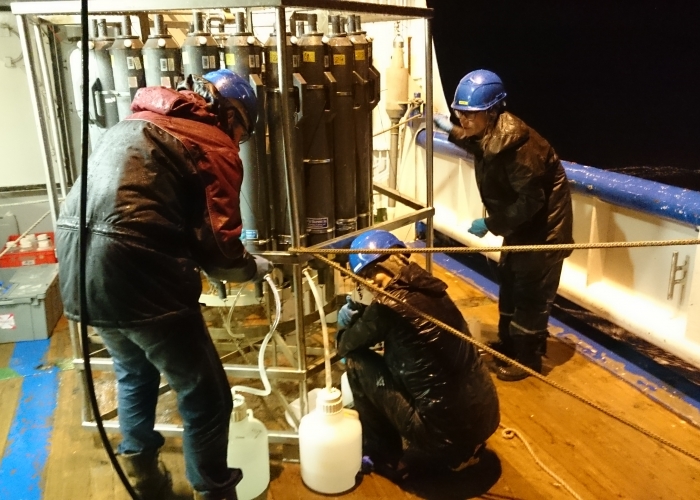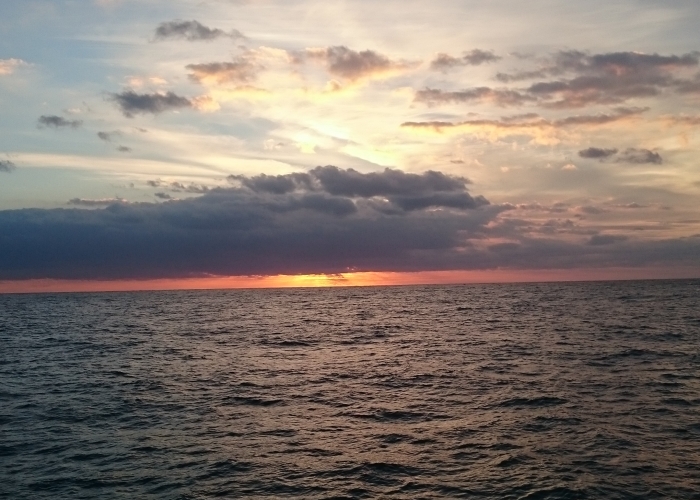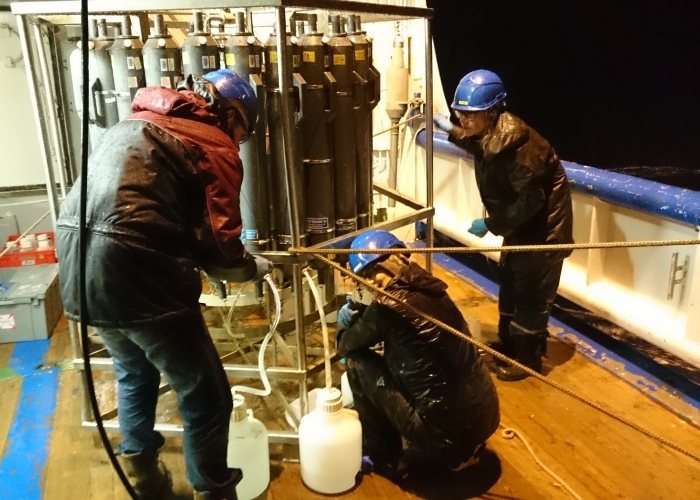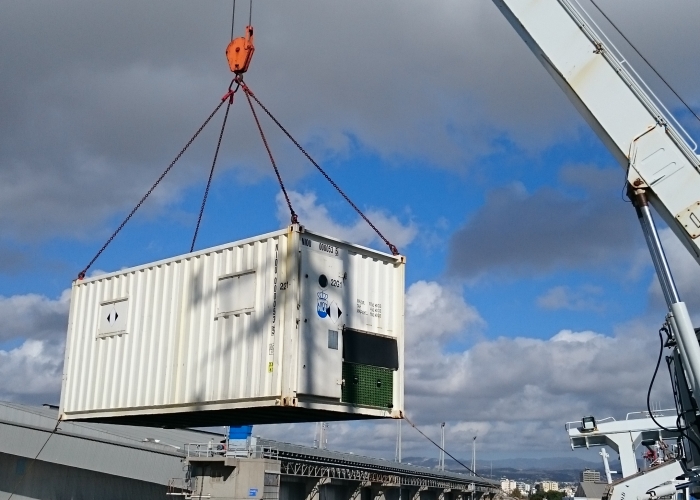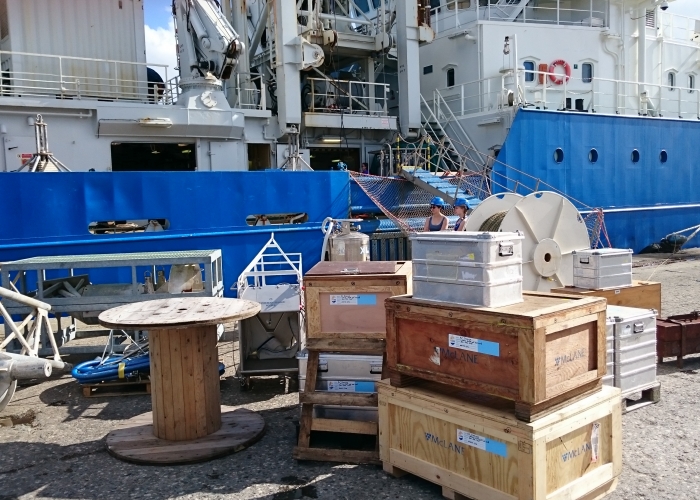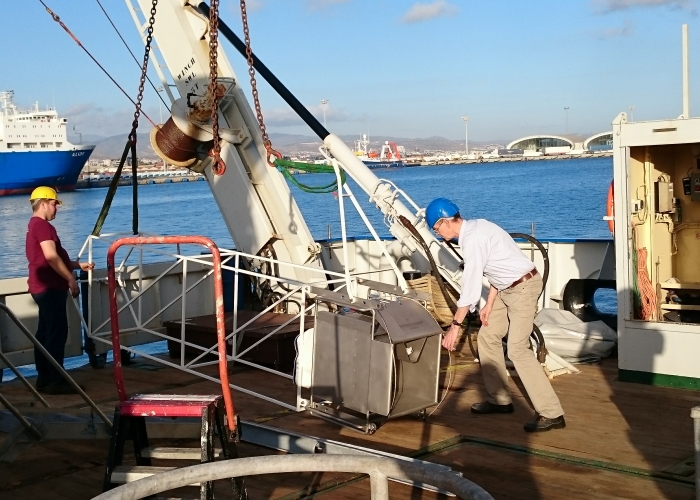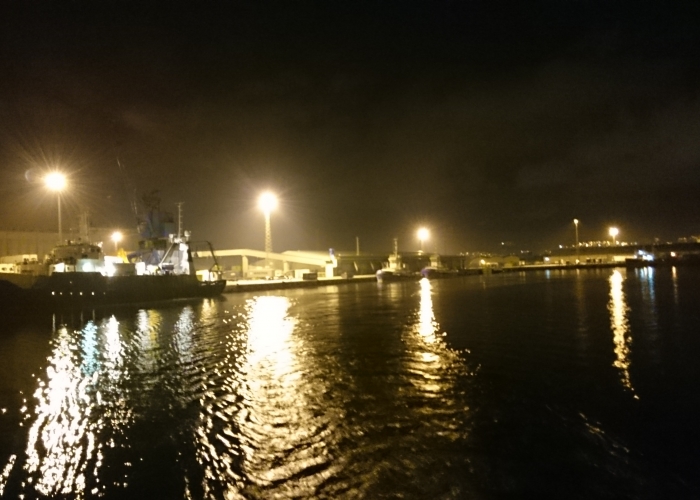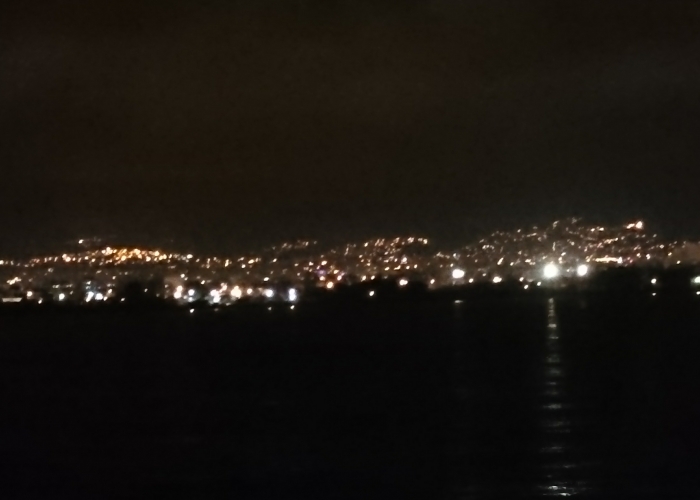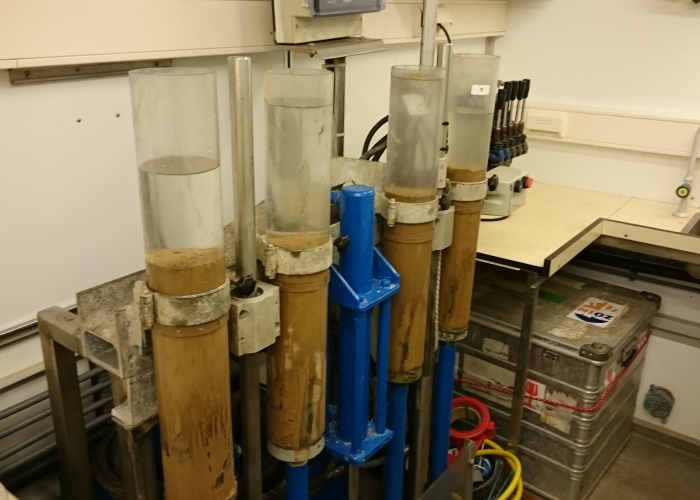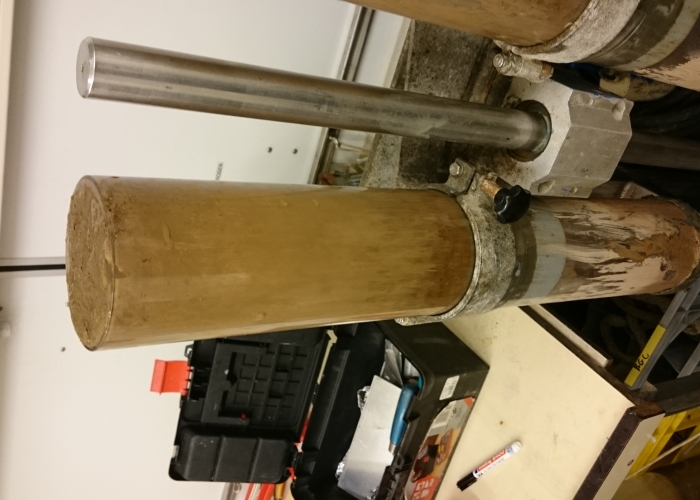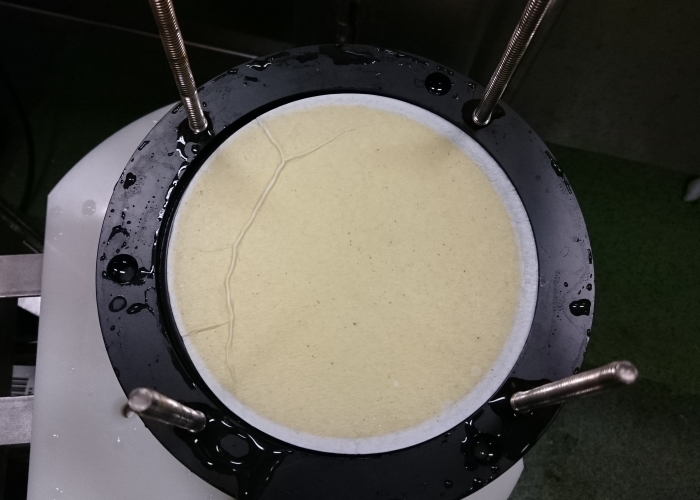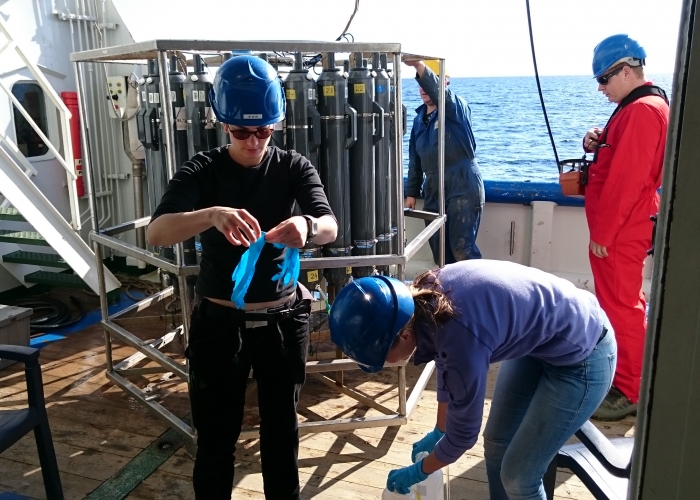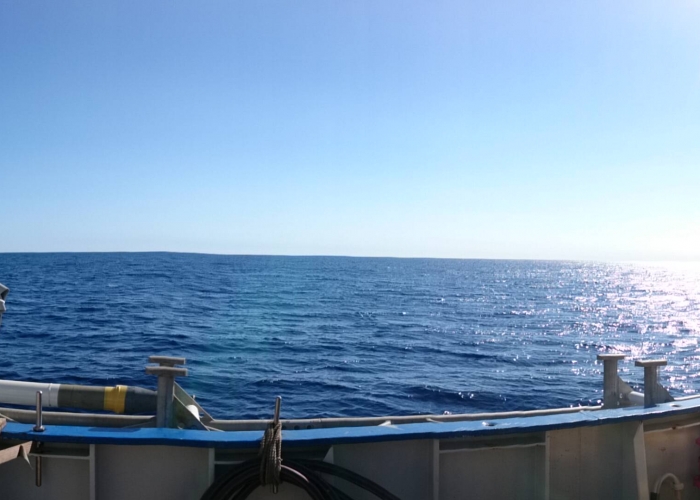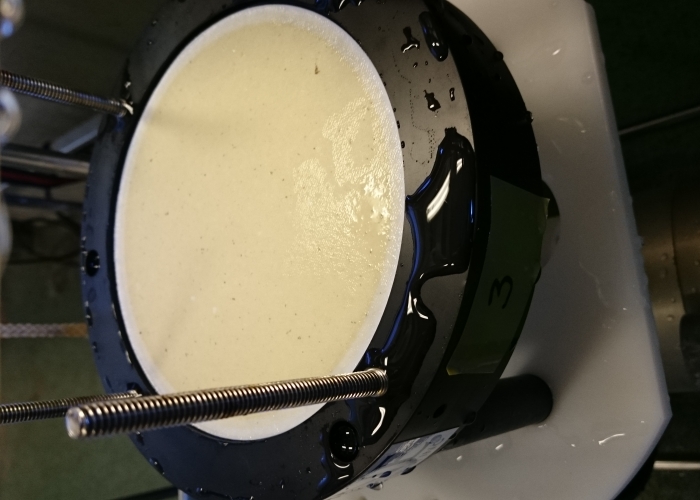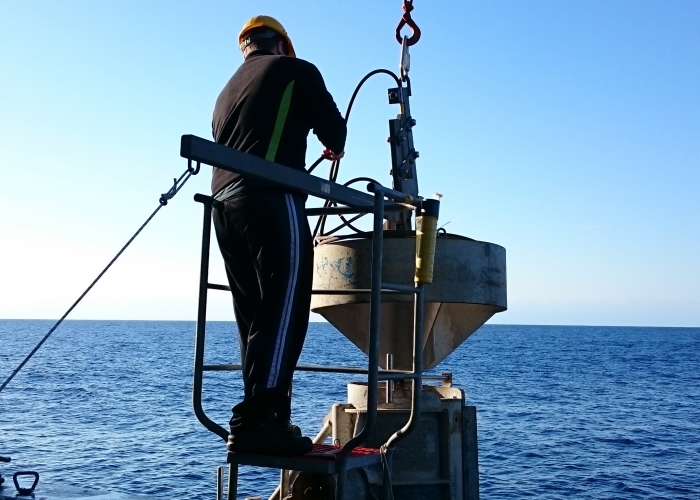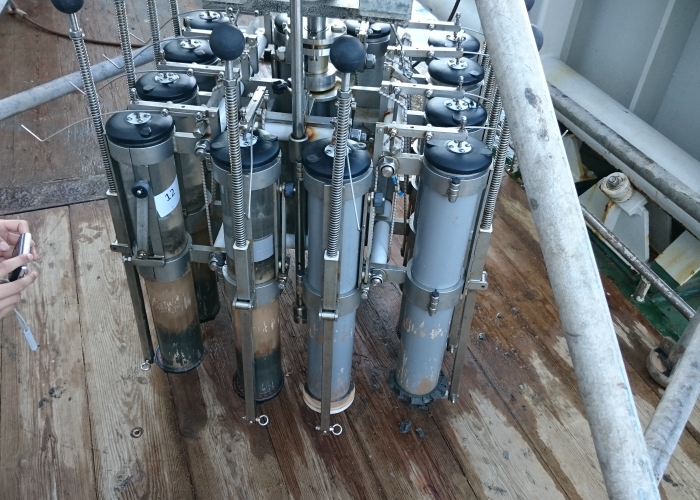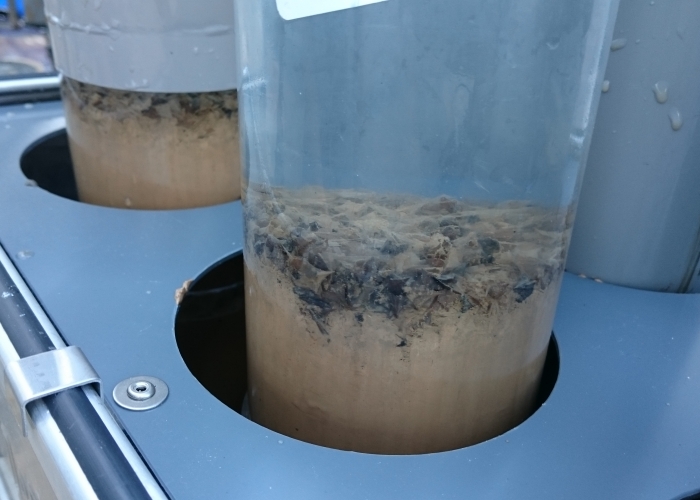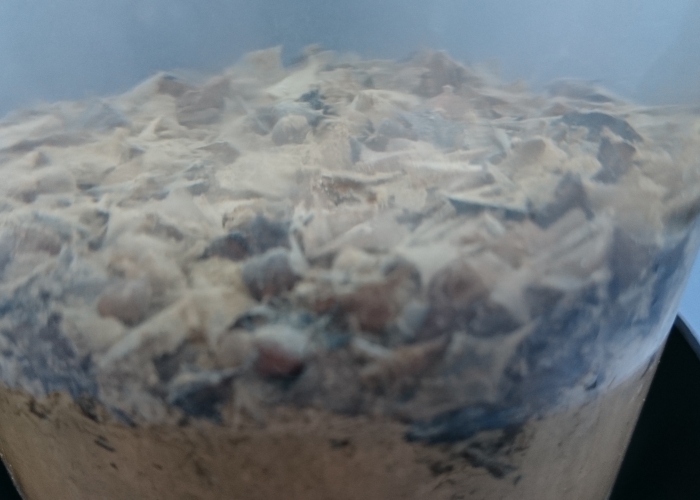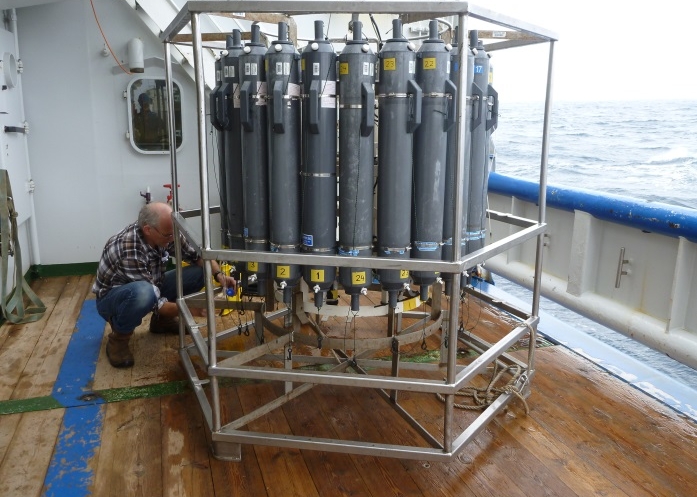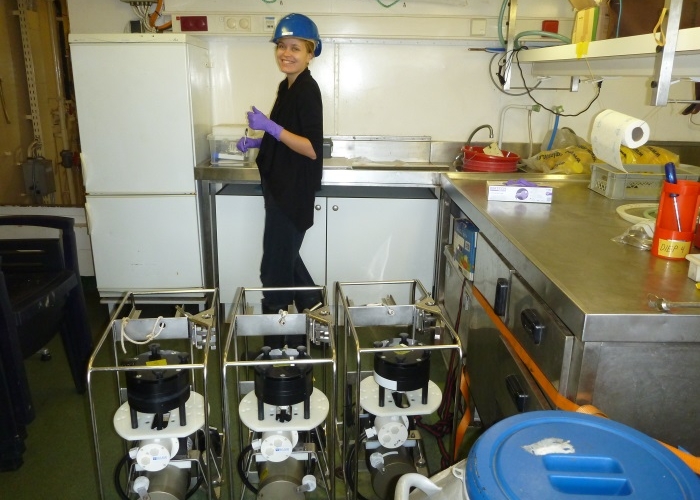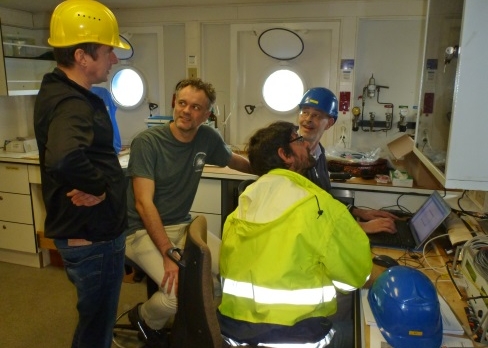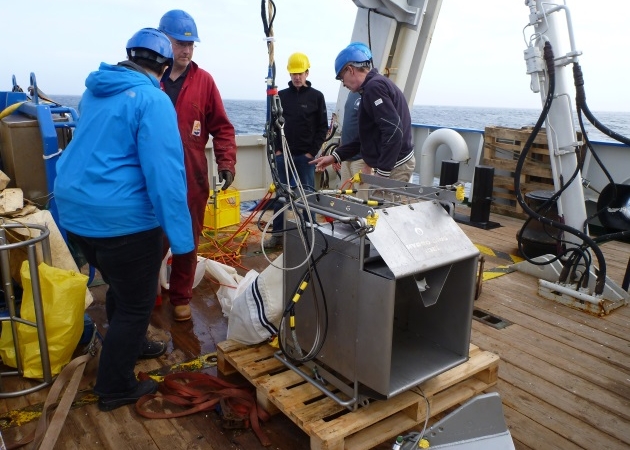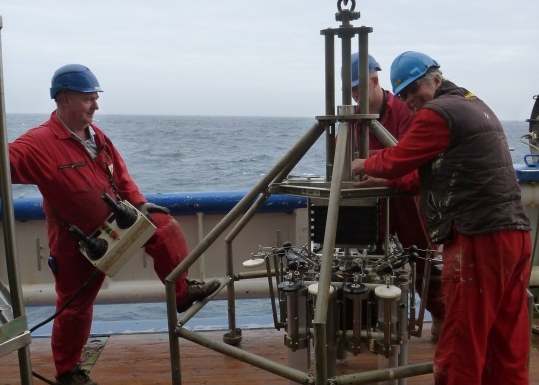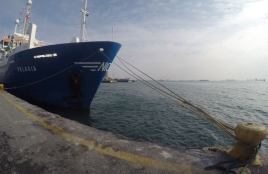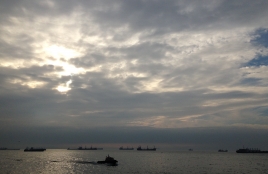NESSC Cruise 2016 Blog
Some of our NESSC researchers are currently sailing the Western Mediterranean Sea on the Pelagia, the research vessel of NIOZ. This picture gallery gives an impression of life (and research) on board. Below, you can read the blog posts written by participants (with the most recent one starting from the top).
To see the latest updates – have a look on our facebook page
Monday 22-02-16
64PE407 Western Mediterranean Sea. Blog written by Saara Suominen (NIOZ/SIAM).
Greetings from the Pelagia! After a calm winter day of hiding from some north-easterly winds, we arrived at our next station full of renewed motivation. This station was looked upon with some dread before we arrived, because it was our high-resolution sampling spot. Instead of getting a glimpse of the first 100 meters of the ocean surface, our plan was to make 12 sampling points across the 2000 meters of water that carried us.
Everything started wonderfully with a scan of the seafloor and collecting water from our sampling bottles, with the help of 5 scientists-to-be (Anne, Shaun, Gabriella, Saara, Eveline) and our analyst, Karel. All went quickly and efficiently, and we were ready to filter ahead of schedule. However something interrupted our unconstrained concentration as a shout came from deck: dolphins! Actually a family of Risso’s dolphins that found an interesting spot for a Sunday outing from our small vessel. They circled around us with two small ones for some time, while everyone abandoned their stations to return the interest. The multinet was being deployed by Lennart and Geert-Jan at the same time, so maybe they were curious to see what we had managed to find. 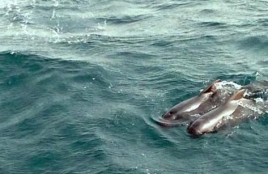
We quickly noticed ourselves, that we had come across a very dense green soup; the water we were sampling was full of phytoplankton. In other words we were in the middle of green slime, and it was clogging our sampling devices. We also had a special occasion with colossal pieces of shipmade apple pie to celebrate our second officer’s birthday. So with being both physically and samplewise fulfilled we continued our work with pleasure.
Soon it was time for a pumping fest! When you want to collect particles from hundreds of meters, you can use the in-situ pumps which automatically pump water through a filter at the depth they are lowered to. That way you don’t have to bring the water on board the ship first, and you disturb the water column as little as possible. It also means that in most places, to get enough material for the analyses to be made at home, you should filter hundreds to thousands of liters of water, which takes, despite the automatic system, a lot of time. With twelve depths to go, three pumps, and a maximum of four hours per each depth to be used, it would take us at least 16 hours to get all the sampling done. At 2am we were still up with the pumps and Wim-Jan even had the inspiration to bake gevulde koeken, to be enjoyed the next day. With the help of Saara, Eveline, Lennart, Roel, Jose, Wim-Jan and Hein, everything was finally ready and sampled the next morning at eight o’clock. We also managed to take our technical interest to its limits and start using our go-pro cameras. Videos of sampling from the point of view of a pump and an afternoon of work on the deck will be soon uploaded to the website.
Today we have continued our in-depth look into this station with sediment samples, including multicores for surface analysis sliced by Gabriella and Eveline, oxygen profiling by Pia, and one long core that penetrated 8,31 meters into the seafloor. Traditionally everyone guesses how long our cores will be, and this time with a guess of 8,28 meters the winner was Gabriella! After the cores were safely up, we were immediately off, spending the day writing down our results and trying to find out how to best display our work. The good weather that we had today and the feeling of moving again, has made us more than ready to take on the next three days, which will also mark the last of this cruise.
Saturday 20-02-16
64PE407 Western Mediterranean Sea (by Geert-Jan Brummer, NIOZ)
So there we are, hiding in a bay off Cabo de Gato near Almeria for a heavy storm raging further outwards. It just doesn’t make sense to go to the next sampling station. First of all it would take very long to get there against eight meter (!) high waves as the Pelagia literally needs to climb up each wave, losing all its speed, and then falling into the deep gap behind it to be stopped by the next wave. Doing so is accompanied by a thundering “bang” as the bow crashes into the next wave, more often than not causing a prolonged shivering of the entire ship. As a result the net speed of the ship is reduced to less than the pace a kid can walk, despite having the engines at full power. No need to say that this kind of movement really gets people sea sick again, so they have a hard time working anyway. And even if we would arrive at the sampling station, there is not much to do since we cannot sample anyway. This kind of sea state makes sampling simply impossible: not only the people but also the gear gets hurt if not lost. When in the middle of the ocean, one cannot escape such storms and just have to ride it out. No decent sleep because beds tend to move with the ship and so do we in response to that. All kinds of things start flying around and even people do in some of the front end cabins of the ship. Ever thought of how the cook should keep his pans on the stove, if not the food in his pans? Even the ship’s navigation system thinks it was a good idea to shelter: as the next station would be 4700 miles away….
Sailing close to land, we have a choice here and look for a bay that protects the ship and us from being tossed about without any good reason. Rather, we are relatively stable now giving us the opportunity, finally, to catch up with the paper work, such as entering all kinds of data acquired over the past days, or writing the first version of the shipboard report (threatened that if we do not deliver by the time we arrive in Cadiz, we are forced to sail again for another couple of days until the harbor in Texel…). Or take a decent shower without having to hold on for dear life while showering in a storm. In between one takes a break in the “wet lab” mid ship, with a view on what used to be a typical Andalusian small fishing village in the Spanish desert, but has turned into a plastic sea. First some thought we were looking at salt plains, but that cannot be since salt plains should be plain rather than running uphill. Others have been there and know what it is … a plastic sea, hiding square kilometers of vegetables and fruits being grown below it: tomatoes, peppers, what have you. Among some of us there was quite an urge to try and go onshore and get some of these, since we are slowly starting to run out of fresh stuff, or perhaps get a decent bottle of red wine with a great ham… Talking about food, the cook just managed to make his first bread, which is quite an art, helped by one of the scientists: quite a change from the dry stuff from the freezer! Never a dull moment….
Friday 19-02-16
64PE407 Western Mediterranean Sea (by Linda Dämmer, NIOZ)
Yesterday afternoon we arrived at station 7, SW of the Balearic island Formentera. We finished the CTD sampling and in-situ pumps in the early evening, after that Lennart and Geert-Jan spent almost 5 hours on working with the multi-net until long
after midnight. The multi-net has been one of the more frustrating tasks of the current cruise. Nets have been damaged several times and had either to be fixed by sewing or glueing, or had to be replaced by new nets. Instead of dragging the multi-net behind the ship as it was planned, we now have to let it sink into the sea and pulling it back up at the same location to reduce the stress on the nets and to prevent further damages. This way we filter a lot less water and end up with much smaller plankton
samples, therefore the sampling has to be repeated several times, which is very time consuming. Yesterday evening the multi-net was let down to a depths of up to 800m below the surface, from there it takes about 80min to come back up.
While waiting, the crew tried to fish to get some octopus for today’s lunch, but didn’t see anything but jellyfish. Because it was very late already, we spent the night at the station making a ma of the sea floor and finished our work here, multi-cores and piston core, this morning. The piston cores we’ve got during this cruise so far have mostly had lengths of about 9m (maximum length possible: 11m). While cutting the core into more handy sections of 1m each, Anne, Saara, Pia, Geert-Jan, Gert-Jan and Linda discovered that parts of the pipe were empty, there was a gap (a section filled with seawater instead of sediments) of about 1.65m, therefore today’s core was only 6.36m long, much less than anybody had guessed beforehand.
While Shaun and Anne are finishing filtering and processing yesterday’s water samples, Karel spends the day downstairs in his lab container fixing some minor issues with the VINDTA titration system and the rest of us are looking forward to a
free Friday afternoon! Time to write reports, clean the labs and equipment, get some sleep, or watch a movie and have a drink. The only things that have to be done during transition phases are the LGR sampling every hour, which is mostly done by Anne
and Gabriella, but everybody gets their turn in waking up at 3 AM, crawling down the stairs into the laboratory container and taking a small water sample for isotope analysis half asleep before going back to bed. In addition to the LGR sampling, the plankton pump has to be serviced every 6 hours, during transition phases and at the station. The plankton pump is a fairly easy but effective device. It continuously pumps surface water onto the ship which then runs through a filter, leaving the interesting part – the plankton – behind before being led back into the sea. The
plankton filter has to be replaced regularly, the plankton itself is removed from the filter, packaged, labelled and stored at -80°C to be analysed after the cruise. We’re now on our way to the next station at 36°58.05 ‘N, 01°30.64’ W and will arrive there probably Saturday evening. We’re again expecting some rather unpleasant
weather conditions, after having just recovered from the last storm a few days ago, and might make a small detour to the Spanish coast to avoid the worst parts of the
storm.
Tuesday 16-02-2016
64PE407 Western Mediterranean (by Anne Roepert, NESSC/UU)
It’s been silent on our blog for the last two days and maybe you wondered what we’ve been doing? There are basically two options why there was no blog: 1, because we were so extremely busy with work, or 2, we were having just too much time off and there was nothing to write about.
This time we have to admit to option 2: We’ve been going through a storm for 2 days which basically transformed the Pelagia into a rollercoaster. The wind took up on Sunday afternoon leading to a failed attempt to take a multicore at station 4. Luckily, we tried again on Monday morning and could retrieve the multicore. The build-up of waves made it difficult for Eveline and Gabriella to slice the cores since everything in the container was moving around, including the hydraulic slicer. Lennart and Pia jumped in to offer their help to stabilize things and allowed for a break to combat sea-sickness. The rest of us did their best to get some fresh air and to get labs and accommodation ready for the worst weather still to come.
We arrived at station 5 on Tuesday in the morning, did some multibeaming to get an idea of the topography of the sea floor and then just continued our transit to station 6 because wind and waves made any sampling impossible. So, what do scientists do the whole day on a rocking ship? Several tactics developed to overcome boredom: Linda basically slept the whole day to not feel too nauseous, while most of us tried working on laptops and gave up sooner or later (it does not feel really nice to focus on a moving screen in a moving ship while being moved around). So the major activities of the day burnt down to reading / switching newspapers and watching one movie after the other. Fortunately we could overrule our chief’s suggestion, who voted to see ‘Cowboys versus dinosaurs’. Further we continued to dance around with the goal to stay upright between chairs sliding around and glasses smashing to the ground.
The night hit hard with most of us not sleeping for the first half, when waves where still high. I had to get up twice to collect rolling water bottles from my floor, which drove me crazy and tie together some clothes hangers to prevent them from banging around in the cupboard. Geert-Jan was thrown out of bed and apparently bruised some ribs. He’s still laughing, but doesn’t enjoy jokes as much as before. On Wednesday morning, great relief overcame us when we realized that the weather improved – we could open our portholes again to finally see the SUN.
Ready for the next station! Cheers, Anne
Sunday 14-02-2016
(By Lennart de Nooijer, NIOZ) Valentine’s day! Probably romance is not on anyone’s mind now, since tonight we sailed right into a storm leaving most of us (at least the scientists) in bed this morning. The weather forecast tells us that by the time we reach the next station, close to Sardinia, the wind will have lied down a bit. For most deployments, this is necessary since rough weather increases the risk of damage to the equipment and reduces safety for those deploying it. But before we reach the next station, we honour the old geologists’ tradition of having a glass of port wine and listening to a bit of classical music before lunch time.
Yesterday evening we used the multinet in a different way. Friday, it turned out that towing it horizontally was a not a success as it destroyed three out of five nets (much to Geert-Jan’s frustration). Vertically hauling the multinet worked better, although the low density of planktonic organisms here in the Mediterranean will require multiple vertical casts per station. In any case, the piston cores collected so far are very long and the slicing by Anne, Linda, Saara and Gert-Jan went very efficient.
There were some hiccups with the VINDTA machine, a device that measures the acidity and CO2 content of collected seawater with a very high precision. Karel and Lennart managed to fix all the problems with the machine (broken cooler, fluctuating nitrogen pressure, etc.) and after a long night’s measuring campaign, the machine now runs smoothly. This will condemn Karel to sit by himself every evening for the coming 2 weeks in a container downstairs and measure all filtered water samples we collect.
The evening was reserved for the multicore. This is a device with 12 hollow tubes that can be inserted into the sediment at the seafloor. At a depth of 1300 meters, it took quite some time to lower the multicore to the bottom of the seafloor and haul it back up to the deck of the ship. Once it was back (past midnight), it turned out that the sealing had closed before the tubes reached the seafloor. It is a mystery why this (has not) happened, but tomorrow morning we’ll try again.
Saturday 13-02-2016
64PE407 Western Mediterranean
We are currently sailing between Tunisia and Sicily. This blog is written on what is already the third day of this cruise. Finally everyone has settled in what they should be doing and got used to life at sea. However, because of heavy winds and high waves, many people experienced – or are still experiencing – short or somewhat longer episodes of seasickness. We have many tasks on board, which we will try to explain in this blog.
Every day starts with the CTD cast, in order to get a depth profile of the seawater of e.g. nutrients, oxygen, temperature and salinity. Anne, Shaun and Karel sample water from the CTD, to do more detailed measurements on the characteristics of the water column. Based on these results, depths in which the in-situ pumps should be deployed are determined. These in-situ pumps filter the seawater, catching microscopic things floating in the water. After the in-situ pumps are again on deck, Geert-Jan, Lennart, Gert-Jan and Linda start preparing the multi-nets. In total, the multi-net contains 5 nets that open at different depths to collect living plankton. Unfortunately, there appears to be a curse on the multi-net, since we lost our first multi-net already on the first cruise. Today, we tried again with the multi-net, and this time the nets were torn. Fortunately, we still have some spare ones, so hopefully it will only get better from now on. After this, Gabriella, Pia and Eveline start working on the multi-core. The multi-core is used to get short columns (max 60 cm) from the seafloor, in order develop methods to better estimate past temperatures, searching for micro-fossils and micro-organisms that change their chemical composition in response to the environment. This cruise is part of the Netherlands Earth System Science Center, specifically aiming at better knowing the response of climate to increased greenhouse gas concentrations in the atmosphere. One of the ways of doing that is through studying past climates. After the multi-cores are collected, Gabriella and Eveline start a long process of slicing the muddy cores into thin slices. Yesterday, we found nice thin ash-layers in the cores, probably coming from eruptions of the nearby Etna volcano. The piston core is probably the most exciting moment of the day. This core is used to go even further back in time, because we drilled almost 10 meters in the ocean’s floor. With the average sedimentation rate locally this might provide us with information going back more than hundred thousand years in time. This long core needs to be sliced in sections of 1 meter, because of transport and storage. Plankton pump samples are taken every 6 hours, filtering surface water and leaving behind the living planktonic specimens in the sieve. All these tasks are a 24 hour per day process, since in between all these deployments, other factors have to be measured (sometimes even every hour, also at night). At the end of the day, even though it might have become really late, many people go to the bar and chat about their day or science. Tomorrow there is a big storm coming up…., so hopefully all the seasickness medicines will help.
Thursday 04-02-2016
64PE408 Black Sea NESSC/SIAM cruise
At the last minute of this mellow cruise (obviously in terms of weather, not work!), we did encounter some heavy wind force this morning: sailing towards the Bosporus, we had a pretty nasty headwind of 8 Bft. Of course this was just a light breeze for our hardened seamen (Marcel, Gabriella, Anne, Saara and all crew members) who survived the big storm on the Mediterranean.
We made it to the lighthouse at the entrance of the Bosporus around 8 in the morning, and luckily the Turkish were much more cooperative this time. We got a pilot to guide us through, and we could just sail on to the other end. There were even some dolphins spotted! At the end of the Bosporus, with a nice view on the Hagia Sophia, we were anchored for a while, because the wind was too strong to be able to dock. Around 16.30 we finally arrived at the dock, the same one as a week ago, still bouncing on the waves.
While some of us managed to clean our cabins and containers, others still had some work: Saara, Anne and Ellen still had some filtering to do. Saara was also up until late last night, together with Daan and Irene to extract the pore water from the sediment cores. This time that went really well; lots of water came out. They will use the water to make a chemical profile of the sediment, to see which nutrients are available for the microorganisms. The sediments itself are also used of course: Daan put the cores as fast as possible in a glove bag (a sort of tent filled with nitrogen instead of air), and put the sediment into bottles with growth medium. By doing this as fast and anoxically as possible, the microorganisms will hopefully not be damaged by oxygen. The bottles with medium will give the anaerobic microbes the food they need to grow, so they can be cultivated in the lab.
Gabriella joined them in the same container (in which it’s supposed to be around the temperature of the water in the Black Sea, so 8 degrees – that’s pretty cold!). She sliced the sediment cores in pancakes of 1 cm again, which takes a while with three cores and more than 40 cm to go. The samples go into bags to be analyzed later for different reasons. Gabriella herself for instance will investigate the remnants of an abundant algae species called coccolithophores, to look at the composition of a chemical compound those organisms make. This might be a great tool for reconstructing sea water salinity.
Those slicing and water extraction activities took the four until early morning, in a container smelling like rotten eggs because of the sulfide. This is illustrative of this whole cruise: people have been working their asses off. Also the crew has been really great: they offered lots of help and were very flexible. Tomorrow the scientists will be getting off board, to either go back to Holland or have five days off before boarding again in Sicily. That will be the last leg of this cruise, sampling in the Western Mediterranean. Updates will follow!
Wednesday 03-02-2016
64PE408 Black Sea NESSC/SIAM cruise
We’re already on the move again! Since the Bosporus has limited time slots for sailing through it, it’s important to be on time so we will reach Istanbul before everyone is missing their flights etc. However, the work is far from done.
Today the in situ pump was deployed again several times to filter water in different depths. And especially Anne and Ellen were working hard with filtering samples. That needs to be done for multiple reasons. For instance, Saara’s incubations were done to look at what kind of archaea take up which kind of nutrients. In order to find that out, you can filter your incubation medium, so the archaea get stuck on the filter; after, you can label them with a technique called FISH, which works with fluorescent probes that stick to certain parts of the DNA. Now you know what kind of archaea are in the sample, but you still want to know which role they play. That’s were Anne comes in: with the method she works with, called nanoSIMS, she can hopefully track the labeled elements that were put in the growth medium and see which archaea took up which nutrients.
Apart from all the filtering and in situ pump action, the multicorer was deployed again. This time the sediment cores looked really good, because Marcel decided there should be a little less weights on the device to make the cores less full (so the stoppers could be put on properly). That means that Daan and Irene can get new pore water, and Gabriella can start slicing sediments again!
Hopefully we’ll be back in Istanbul by lunch tomorrow. Until that time, I guess it will be little sleep and lots of work, to get everything done in time. But the going away present from the Black Sea was perfect: we got to see a really really nice sunset today.
Tuesday 02-02-2016
64PE408 Black Sea NESSC/SIAM cruise
The day started with a beautiful sunrise, and the retrieval of the in situ pump. Everyone was quite excited to get to work, because there would be a birthday cake for coffee break! Afterwards, there was another cast of the Ultra Clean CTD with lots of water from 50m and a second one for water from different depths. Also, the in situ pumps were deployed again to collect biomass at different depths. The scientists were working hard filtering, incubating or titrating their water samples – hence in terms of science, today was not that different from yesterday.
As for the rest of today’s blog, Daan (from SIAM) wrote something about the background of this cruise from the perspective of a scientist.
—
Just like a cruise, science is about finding out things together, in collaboration.
The next step is telling the story of our findings. That can be with the aim of doing more research, of making well-informed political decisions, of developing new technology, but it can also be out of simple curiosity. “How does the world work?” is always an interesting question, for any age and for any level. And since people have been wondering about this question for some time already, usually the answer is as short, or as long, as you want to have it. Car engines, for instance, are pretty complex. Still, if you would describe it as “It makes power out of fuel”, you have got the most important part of it covered.
Biologists do not think so much about engines however. More often our thoughts are about evolution, for instance. Rineke (the writer of this blog) and me were discussing yesterday how to explain the difference between the two kind of microbes we study: bacteria and archaea. Most of them look pretty much the same, so it is not as easy as pointing out the difference between, say, humans and trees.
But shockingly, the difference between humans and trees is not so big compared to the difference between bacteria and archaea. When life was still a baby, and trees and humans did not even exist, already bacteria and archaea were evolving separately. Both groups developed neat tricks to grow, such as eating sulfur, or producing natural gas or oxygen. But it was not until things like humans and trees came around that anything bigger than one cell lived on this planet.
One of the big questions in evolution was “Did humans and trees then evolve from archaea or bacteria?”. Excitingly, the answer was found by a Swedish research group last year: we come from the archaea. They found this by analyzing archaea from marine sediments near Norway, which were sampled during a cruise just like this one.
Monday 01-02-2016
64PE408 Black Sea NESSC/SIAM cruise
It turns out some people did have problems with the increased movement of the ship yesterday, including yours truly. Luckily, this morning everything was much better again, because there was more time for sleep and the wind died down a bit. That, and the pancakes our cook made for breakfast got us all ready for a new day of sampling.
After breakfast the Ultra Clean CTD was deployed again, firstly for Saara to sample 220 liters sea water. That seems like lot, but she needs this much water to find certain archaea species (archaea are as small as bacteria, but they belong to another domain because they differ from bacteria as much as we differ from, well, bacteria). The archaea Saara is looking for have been recorded at this depth, and she will try to cultivate them. She is incubating the water with multiple substances, such as antibiotics to eliminate the other bacteria and labelled amino acids or other food sources so she can track them later.
The Ultra Clean CTD was used again to sample water from different depths. Afterwards, the in situ pumps were cast down multiple times, to filter the water at different depths to collect a concentrated biomass sample. Irene and Daan will use this for their cultivations of anaerobic bacteria, for example.
In the meantime Anne and Ellen were doing a lot of water filtering. Anne wants to find coccoliths (some sort of algae with an arrangement of calcium carbonate around them) in the sea water for further analysis, because they might be a good proxy for salinity. To be able to find them, you need to filter out all other stuff if possible. Ellen was filtering samples from the Ultra Clean CTD to generate all kinds of background data such as nutrient concentrations.
Everything went pretty OK today, except being a bit behind on schedule and the filtering going slow. But Ellen’s comment is pretty adequate: ‘als het niet gaat zoals het moet, moet het maar zoals het gaat’ (if it doesn’t go as it should, it should just go the way it does).
Weather-wise, today was grey and rainy but less windy. Unfortunately we’re expecting a bad blow later tonight. It will not as bad as the previous cruise leg, but it might be a bit uncomfortable. We’ll see!
Sunday 31-01-2016
64PE408 Black Sea NESSC/SIAM cruise
We sure have some hardcore scientists on board. Even when most of them had to stay up until 2am to finish slicing the sediment cores or take care of the piston core, they were already up and running at 5am again. The CTD was deployed at the moment we arrived at station 2, which was in the middle of the night. This time the CTD collected water at several depths, so a few hours later the collected water had to be processed.
After that, the Ultra Clean CTD was used to take water samples as well, but this time the samples needed to stay anoxic (hence the Ultra Clean one). Saara emptied the CTD pipes in anoxic bottles using nitrogen to flush them out. That seemed to go quite well. Daan could then add an indicator to the water to see whether or not there actually was no oxygen in the water. The SIAM people want to know more about anaerobic microbes in the Black Sea, and to be able to cultivate the ones collected here, there should be no oxygen at all in the medium. Anne and Irene were describing the layers and taking samples of the piston cores, while Gabriella titrated the water to determine the alkalinity of the collected sea water.
Afterwards, a couple of in situ pumps were deployed, to filter the water at different depths to collect the microbes in it. The filters are currently handled.
The winds are getting somewhat stronger, so today the Pelagia was bouncing a bit more. But it seems everybody stayed strong. Just keeping busy might do the trick. Another thing that is important to learn if you want to survive on this ship: respect the lunch bell and eat quickly! While we get three delicious courses every day at lunch, the serving pace is faster than McDonalds. Oh well, no one has lots of time for a break anyway.
We’ll be back tomorrow for another update!
Saturday 30-01-2016
64PE408 Black Sea NESSC/SIAM cruise
Finally, around 1 in the morning, we had permission to sail the Bosporus. With the start of our transit to the Black Sea, the second leg of the NESSC cruise has really started!
Sailing to the first station, the Black Sea had a nice surprise: we encountered some dolphins!I tried multiple times to upload the video on Facebook, but unfortunately the internet connection is not really cooperating. Well anyway, they were playing really nicely in the bow of the ship.
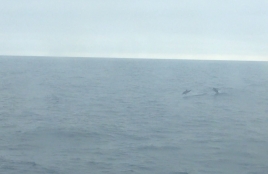
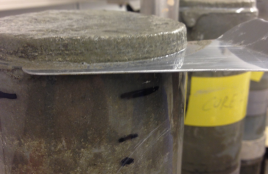
Around 2pm we arrived at the first station, where we took the CTD to the 1940m deep seafloor (the CTD is a device that can measure parameters of the seawater, including temperature, salinity, density and oxygen). Secondly the multicorer was employed, to take sediment cores of 60 cm from the top of the seafloor. That was a bit tricky: the cores were too full to put the stoppers on properly, so some of the sediments well out. Gabriella and Marcel worked hard to save enough of them though. The typical sulfide smell of the Black Sea was well noticeable, thanks to all the anaerobic microbes.
Gabriella went on slicing the multicores in pancakes of 1cm, to analyze them later. The others took a piston core, without the piston, so it’s actually just a gravity core. It reached a not so impressive 5 meters depth. Irene and Daan wanted to get some pore water out of them, but it turned out there was not much water in it, because the sediment is really dense.
While we are sailing on to our next station, the science team is trying to figure out the planning of the next few hours – it looks like sleep might have to wait. We will arrive soon at the new location, and the CTD will be used immediately to take water samples in different depths. And of course there is a lot more to be done. Fortunately, the weather is perfect, with almost no waves and only a little wind. So sea sickness can’t really be an excuse – all hands on deck!
Friday 29-01-2016
64PE408 Black Sea NESSC/SIAM cruise
Yesterday SIAM colleagues Daan en Irene arrived in Istanbul, together with Ellen and Marianne from NIOZ and Rineke from NESSC. This leg is a NESSC/SIAM combined cruise – collaboration between two NWO gravitation programs in action! SIAM is a research institute for anaerobic microbiology (http://anaerobic-microbiology.eu/), and the Black Sea is a great place for them to sample.
When we saw the Pelagia looming out of the darkness, it looked quite impressive – however, we could not get on board yet. The Turkish harbor agents needed to double check our passports and visas before we were escorted to the dock.
As soon as we walked the plank and got on board, we were assigned to our very own cabin – what a luxury! We got food and a tour, and were all ready to start.
Unfortunately, we couldn’t sail off yet. We are still anchored in the harbor in Istanbul, waiting to head for the Black Sea – the Bosporus is closed because of the construction of a bridge. That’s why there were a lot of ships queued up around us. Hopefully we can depart this evening.
The waiting gave the opportunity to start the day calmly, without any risk of sea sickness. The newbies got a safety tour around the ship (including an abandoning ship drill!) and we held a staff meeting about the planning of the sampling.
If we’re able to leave the harbor in the evening, we will hopefully arrive at our first sampling site tomorrow morning. We’ll be back with an update tomorrow!
Tuesday 26-01-2016, 7:30
Cruise: 64PE406 NESSC East Med
Again an early morning, we started a 3 with a multibeam cast over Station 9 in the Aegean, the “extra” station, originally only meant as piston core station. Although time is becoming more and more limited on our way to Istanbul we decided to also do a CTD cast at this station and collect some water for all the various analyses and filtrations. After the CTD cast and sampling the water from different depths we took a piston core around 5:30 in the morning. This time the total length of the core was relatively short, 1 meter and 78 centimetres, but at the bottom of the core we did find cold water coral remains. The closest core length estimate was mine, even though I guessed 4.39 meter and hoped for even more.
This was our final station and now we will steam for at least 35 hours to reach Istanbul on time for our crew change on the 28th. At the end of the 28th the next cruise, to the Black Sea, will start we a number of fresh crew members and scientist.
We will be back with updates from the Black Sea cruise after Thursday.
Marcel
Monday 25-01-2016, 16:00
Cruise: 64PE406 NESSC East Med
Interesting day today. Early this morning we arrived at Corinth where we took a pilot on-board to get us into the harbour for some official business and take out the trash. After our stop in Corinth we had to take on another pilot to take us through the Corinth Canal, 21.4 meter wide, 6.4 kilometre long, 8 meter deep and approximately 300 meters high. Ships cannot be wider than 17.6 meter and /or have a draft more than 7.3 meter. I guess all together we took several hundreds of pictures with smartphones, different types of cameras and goPro’s. Quite impressive 6 kilometre!
We are now on our way to our last station which is in the Aegean Sea, before heading to Istanbul where we will arrive Wednesday the 27th at the end of the afternoon.
I hope you will enjoy some of our pictures of the canal,
Marcel
Saturday 23-01-2016, 18:30
The morning started a bit rough again, but by the time we neared the coast of Calabria it had turned into a beautiful afternoon. After a sweep of the sea floor for potential coring sites and finding a nice spot, we took another piston core. From the grey mud on the outside of the core you can already tell it is a nice long core and indeed it ended up being 8 meters and 84 centimetres (Alex won, again). The core was brought on to the deck and cut into 1 meter pieces by a large number of us, including our master core cutter Esmee. For now it’s bye, bye Calabria and we’re on our way to the Corinth Canal where we will arrive early Monday morning.
Marcel
Friday 22-01-2016, 16:00
Cruise: 64PE406 NESSC East Med
Some of us witnessed another beautiful sun rise over a very quiet sea this morning. Saara’s in situ pump deployments took all night, fortunately some deployments take 4 hours or even a bit longer in total, so there is some time to sleep in between. I would have thought that sleeping almost 4 hours twice would be similar to sleeping almost 8 hours at once, it’s not! The last deployment ended at 12:30, right at lunch time. After lunch the sediment trap mooring we picked up yesterday was put back at approximately the same spot we collected it from after being serviced in the last 24 hours by Roald and Geert-Jan with some help of others. This very well-orchestrated exercise ended with the big splash of the mooring weight into the Mediterranean, very nice.
In the meantime, samples are being repacked and organised in fridges and freezers. Several people are learning new skills from their colleges for future cruises, like the next cruise in the Black Sea or the one thereafter in the Western Mediterranean. Information is being organized for the cruise report etc. Everyone is making the most use of our, so far very quiet, transit to Calabria where we will be arriving around lunch tomorrow.
I am now going to add almost 2 hours of sleep to my two times almost 4 hours from last night.
Marcel
Thursday 21-01-2016, 14:00
Cruise: 64PE406 NESSC East Med
There is not even a glimpse of the storm from a few days ago any more, the sea is so quiet, the weather so nice, finally we know where we are …. in the Mediterranean! Perfect timing as well, since today we had to pick-up and service a sediment trap that was deployed here last year. We arrive at station 6 around 2 in the morning and started with a multi-beam cast to get an idea of the sea floor around the mooring followed by a CTD cast to get an idea of temperature, oxygen concentration, salinity etc. with depth and to collect water on the way up. That started at 4 and when the CTD was back on deck it was really busy with people sampling the water for all kinds of purposes.
Around first light the mooring was released and floated to the sea surface as you can see from the yellow balls next to the ship in the pictures. Also in the pictures is how the sediment trap looks when it is getting on board. Basically a big funnel that collects sinking particles in a small jar and can change jars to collect material from different time periods separately. It is currently being serviced on the deck and will be deployed again tomorrow morning.
In the meantime we collected a piston core at this station, 9 meters and 68 centimetres, Saara was our lucky winner today. The core came on deck a little before lunch and Leon, the cook on board, does not only prepare delicious food, but is also very helpful for those of use that have to finish cutting a core, for instance, and would like to eat a little later. Excellent!
Now the multi-core is coming back up and after that we will do several deployments with the in situ pumps at 12 different depths, including really deep. Something that will take us through the night into Friday morning and is only possible with an extremely capable, dedicated and flexible crew. After deploying the serviced trap we will transit to Calabria to take another piston core, before setting “sail” for the Aegean Sea and ultimately Istanbul.
For us no ice skating, but days like this make up for that (I think). Have fun,
Marcel
Wednesday 20-01-2016, 8:00
Cruise: 64PE406 NESSC East Med
I promised we would be back after the storm and station 4. Unfortunately the storm affected both our transit time and our ability to take samples yesterday morning at station 4, we therefore decided to skip station 4 and directly move on the station 5. The winds started to increase during the second half of Sunday, after we left station 3 and lasted until early Tuesday morning. Typical winds were around wind force 8 or 9 with brief extremes reaching 11 and 12, which slowed us down and turned the Mediterranean in very bouncy sea. Tuesday during the afternoon the winds died down and we had an ok remainder of the transit to station 5 with a beautiful sunset.
The estimated time of arrival at station 5 was around 1 in the morning today and the wind was thought to be reasonable, wind force 5 maybe 6 at the most. Much to my surprise, when I went to the bridge this morning the wind was actually quite strong, wind force 9 again, which made for an interesting night. Around 1 we reached the station and started with a CTD cast thanks to Cor, Rik, Roald and Alle on the bridge. The CTD was back on deck around 2:45 and sampled by Patrick, Esmee, Anne and Saara and in between Saara and Roald also prepared the in situ pumps, cast two of the day. Cor and Rik were there to put the pumps in, Sjaak, Hein and Jan Dirk got them out at 6:30 again. The wind died down and now the multicores are coming up and the slicing will start, the CTD samples are being processed and I am trying not to fall asleep by writing this. The waves look quite ok, so I hope we will also be able to take a piston core before moving to station 6.
Marcel
Sunday 17-01-2016, 13:35
Cruise: 64PE406 NESSC East Med
All bets are off, we decided not to take a Piston core today. There is much more wind and larger waves than yesterday and the Piston corer is a “delicate” machine in some ways and we need it for the rest of this cruise and the next two cruises, can’t risk breaking it.
At this moment the CTD frame is coming up and we have already deployed the Multi corer and we retrieved several nice cores. The weather has changed a bit, there is a lot more wind and movement which some people are not that happy with, everyone is on deck and working hard though. The wind is supposed to increase even further today and especially tomorrow which makes some things more difficult. By changing the order of different deployments we try to get the most out of this station before fighting the increasing winds on our way to the next. Next thing on our list to try is deploying the in situ pumps.
We will be back, probably after station 4 and the “storm”.
Marcel
Saturday 16-01-2016, 16:30
Cruise: 64PE406 NESSC East Med
The Piston core is on its way to the sea floor, all bets are on, how many meters this time? Looking at the Multi-cores it might be another 9 meters or so.
What a beautiful day, sunny, nice temperature, no wind and no waves. Everyone is up and running. Early this morning Bert and Roald started the multi beam and Bert made a few parallel transects for us to pick a nice sampling station, Station 2. After breakfast we started with the CTD, collecting data and water from different depths for various analyses of things dissolved and things that stay behind on filters, with preservation, without, stored in fridges and freezers, everything is possible. During lunch the in- situ pumps were doing their job, followed by the Multi-corer and now the Piston corer. The Multi cores showed a beautiful layer of pteropods (see picture and/or google it, there are some beautiful pictures online).
Tomorrow at Station 3 we might start with a Piston core before the wind kicks in, I hope everyone has found their sea legs. We will keep you informed. Wednesday the weather will get better again. For those of you in the Netherlands, enjoy the snow!
Marcel
Friday 15-01-2016, 09:00
Cruise: 64PE406 NESSC East Med
Currently we are waiting on the last deployment of our in situ pumps, the largest depths, before leaving station 1. The other deployments last night have shown us that we can easily filter more than a thousand litres over a single 0.3 um filter in 4 hours.
We started yesterday morning with the Multi Net while I was writing the previous update, a lot has happened since. It has been a very long day that ended, at least for me, around 1 am when Roald was still working on the second deployment of the in situ pumps together with Cor and Rik. Seasickness hit the scientista quite hard which left us a lot to do and relatively few people to do it with. There have been several things interfering with an already very tight schedule which delayed some of the casts, leaving people, such as Anne, to filter and prep samples well into the night. Some machines are starting to misbehave, while others are being fixed and are running the first samples as I type. Yesterday afternoon we brought a 9 meter and 18 centimetre long piston core on deck, it was cut in one metre pieces and stored. It looked pretty good and much longer than expected, the highest guess/bet was just over 6 meters. Early in the evening we also deployed the multi-corer resulting ina whole series of very nice cores, some of which have been sliced last night and others will be stored as archive cores. To summarize station 1: you win some, you lose some!
Hopefully everyone will get over their seasickness in time for the storm, it looks like Monday will be bad. When we are done here at station 1 we will continue to station 2 where we will arrive early tomorrow morning and the circus can start again.
Marcel
Thursday 14-01-2016, 06:15
Cruise: 64PE406 NESSC East Med
While I am writing this update on deck the Multi Net is being deployed by Geert-Jan, Cor, Rik, Jan-Dirk, Pieter and Bert on the bridge. We’re just a bit east of our station 1 or E1 some 80 miles south of Cyprus and are sailing west against the wind at approximately 1.5 knots over water.
Yesterday our containers arrived around 10 in the morning and everyone, scientists and crew worked their butts off to empty them, get them on board, assemble the piston corer, prepare the labs etc. etc. At 20:00 on Wednesday the 13th we left Limassol and around 22:00 we stopped at station 0 or our test station. We shortly deployed the CTD, closed all the bottles and made sure everything worked for this morning. We, Geert-Jan, Roald, Pieter, Jan-Dirk, Sjaak, Hein and John on the Bridge also deployed the Multi Net to make sure everything worked for the first deep cast, taking place as I type this. In the meantime Patrick and Esmee worked hard in the Vindta container and although there are some issues with the Vindta, the LGR is producing hydrogen and oxygen isotope data. The results so far look very interesting, Piet, and the flow cell seems to the job, Bob.
Last night the wind became a bit stronger and I don’t know how everyone is doing, but during the day it will weaken again. Hopefully this will help with a very successful first real station. As a looks now we will have to deal with a real storm this weekend, by that time everyone should be used to working on board a ship, I hope. Updates will follow!
Marcel


